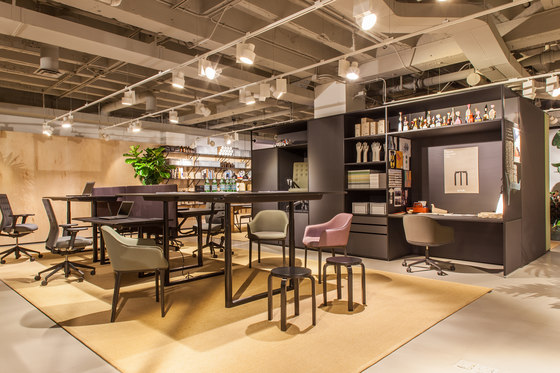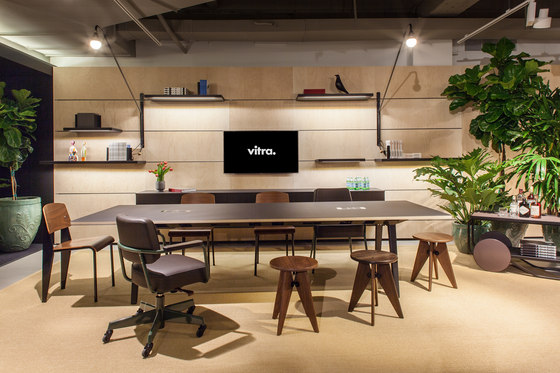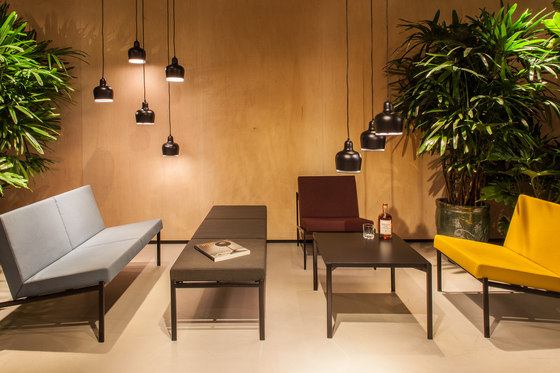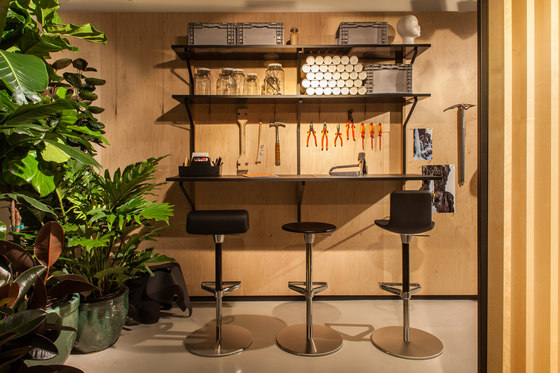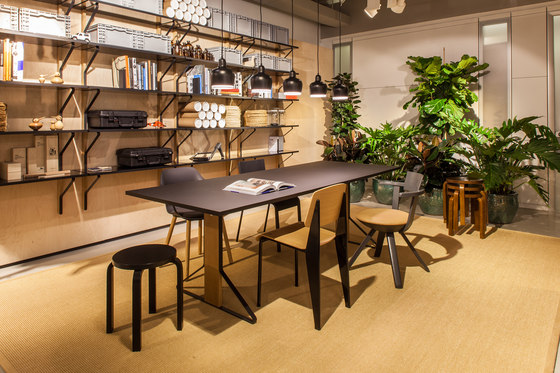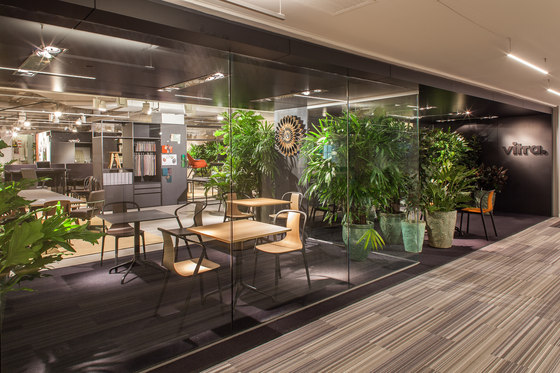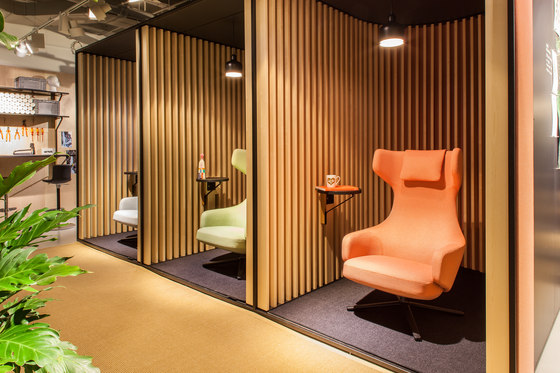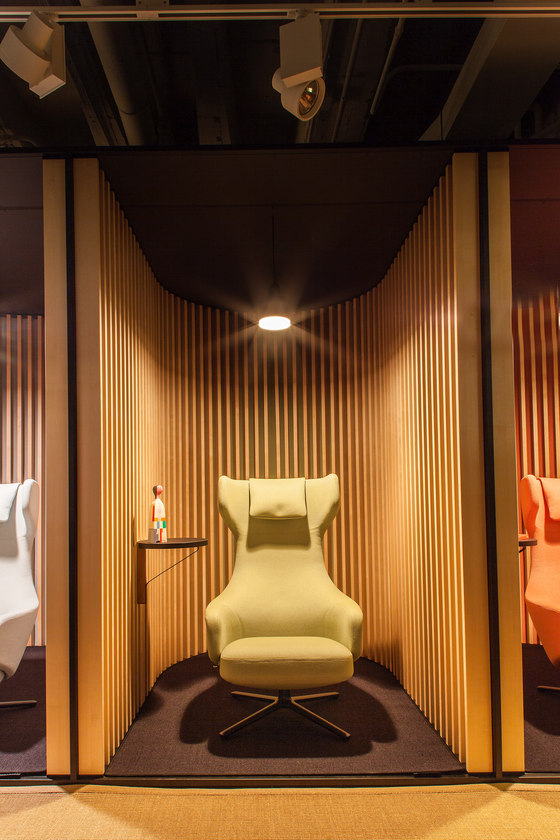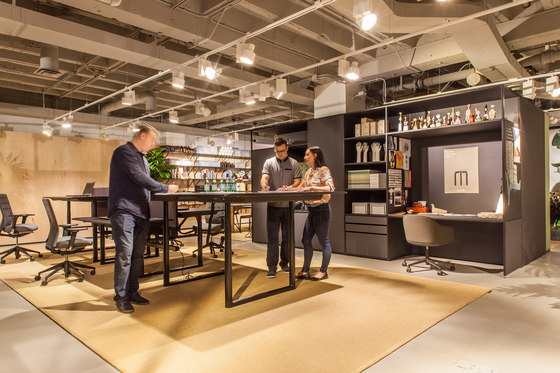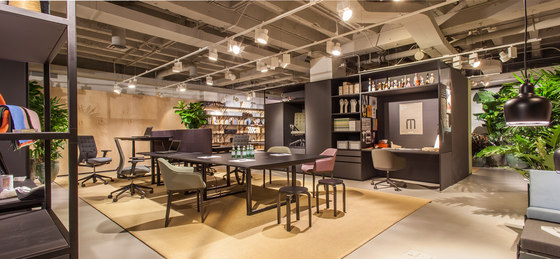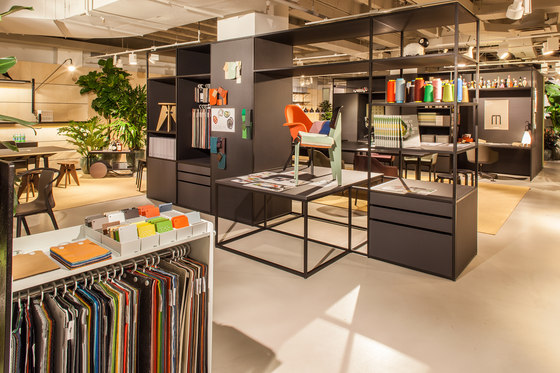For the 2016 edition of NeoCon, Vitra collaborated with Lukas Scherrer. The Swiss-born, San Francisco-based principal of SHIBULERU design presented his vision of an authentic design studio and a creative work culture in action.
On display was an eclectic layering of Vitra and Artek products that blur the traditional distinctions of home, office and public spaces. Iconic classics designed by Jean Prouvé, Alvar Aalto, Eero Saarinen and Charles Eames were layered among contemporary classics by Ronan and Erwan Bouroullec, Konstantin Grcic, Jasper Morrison and Antonio Citterio. Vitra’s showroom was refracted through the prism of the Vitra Color and Material Library, the culmination of ten years of research by Hella Jongerius, Vitra’s Art Director for Colors and Materials.
Vitra’s NeoCon 2016 presentation spanned two Chicago locations that highlighted compelling approaches to workplace design. The NeoCon Showroom at the Merchandise Mart featured North American product introductions. This space was open to all show attendees from June 13 – 15, 2016.
The Project Space was a pop-up location less than 10 minutes walking distance from the Merchandise Mart, and featured a real-world example of Vitra’s client approach to customized applications. On display was Pier, a newly developed benching concept designed by Lukas Scherrer arising from a collaboration between a Swiss client and Vitra. This space was open by appointment only to Vitra clients. Vitra also hosted North America’s top interior design leadership by sponsoring the International Interior Design Association’s Annual Meeting at the Museum of Contemporary Art Chicago.
A Creative Workspace and Corporate Culture
Vitra’s Chicago showroom references the excitement of the American startup garage – an entrepreneurial creative workspace where calculated risk-taking results in industry-changing, disruptive business models. Investments in creative capital will provide tomorrow’s companies significant competitive advantages. A workspace that physically embodies a creative work culture allows organizations to both attract the next generation of highly sought-after talent, and provide a diverse palette of spaces to support creative exchange in its many forms. Lukas Scherrer explores divergent thinking in the workplace by depicting a creative work culture in action. On view in the NeoCon 2016 showroom was an adaptive oce designed to enable D.I.Y. reconfiguration and respond to scalability requirements dictated by rapidly evolving business conditions.
The Evolution of the Silicon Valley Tech Office
At NeoCon 2016, Lukas Scherrer explored the evolution of tech oce design – an aesthetic he calls “Silicon Valley Modern.” Moving beyond well-trodden tech oce clichés, Scherrer crafted a Vitra work environment utilizing an authentic palette of naturally derived linoleum, plywood of di¥erent species, oriented strand board, greenery and sisal. Lukas Scherrer applied Vitra’s Collage Concept to the NeoCon showroom. Vitra maintains that vibrant environments gain character through a mix of old and new, high and low, classic and contemporary.
Cafe Belleville - A Parisian-Inspired Garden Cafe
As work shifts to “third-place” hospitality environments like co¥ee shops and co-working lounges, co¥ee culture has become a significant driver in workplace interactions. To explore this evolving nature of work, Vitra incorporates the Belleville family of chairs and bistro tables into a working café installation that draws on the lush verdancy of a Parisian garden.
Flex Office
Despite the widespread shift to open-plan environments, the private oce still remains a prevalent planning typology in specific North American industries. The engineered simplicity of Vitra’s product portfolio allows facilities planners to make the most of limited real estate. An intelligent kit of parts enables simple and instant transformation of the private oce to proactively anticipate evolving work modes or workplace requirements the moment they arise.
Transversal Elements from Vitra’s Retail Systems Catalogue
Vitra has its roots in the shop-fitting business. In 1934, the founder Willi Fehlbaum took over the Graeter shop-fitting firm in Basel. Together with his wife Erika he went on to establish the company Vitra in 1950, which soon expanded beyond retail interiors. Following the transfer of the company to their sons, Vitra and Vitrashop became two distinct corporate entities in 1984. The latter further split in 2001 into the two brands Visplay and Vizona. As of 2016, Visplay and Vizona returned to their roots and now once again operate under the Vitra brand name. This reintegration enables a greater exploration of manufacturing synergies and the development of transversal products that span multiple market segments.
Open Workspace
At NeoCon 2016, Vitra is demonstrating the high degree of individualization possible for popular products from Vitra’s oce portfolio. New standard materials, fabrics and finishes from the Vitra Color Material Library cast Vitra’s “go-to” oce products in a striking new light. The open workspace vignette in the NeoCon showroom places special emphasis on textiles and upholstery. Tyde’s WorKIt screens, ID Trim task seating and Softshell side seating have been upholstered in new Plano textile colors, designed by Hella Jongerius.
Hybrid Workspaces
At NeoCon 2016, Vitra is presenting a collection of transversal products from both the Vitra and Artek portfolios, suited to the settings of very diverse market segments. These products find their home in start-up oces, public libraries, higher education, hospitality environments, as well as Fortune 500 companies and even residential applications. Mirroring the trend of increasingly relaxed dress codes in the workplace, these transversal products provide the oce with a casual sense of domesticity. Hybrid products enable the design of cross-functional work environments that support diverse work modes simultaneously. A wide spectrum of work occurs in the same space over the course of a a single day; this includes hoteling, coworking, collaborative brainstorming, library study and lunch meetings.
Artek Kiki Lounge
With Kiki, Ilmari Tapiovaara employed a clean-cut design idiom instead of the organic style he had previously favored. Tapiovaara chose oval steel tubing as the structural and unifying element of the whole Kiki collection. Upon it’s initial production in the 1960s, Kiki was a success, influencing the concurrent direction for furniture design during that time. Kiki’s timeless and elegant design idiom has made it one of the most popular pieces of public furniture in Finland. Kiki’s simple geometries provide it a mannequin-like quality and a high capacity for transformation. This timeless, contract-friendly, Nordic-modernist lounge seating collection is now available with COM capabilities. At NeoCon 2016, Kiki is shown in the brand new Volo textile from the Vitra Material Color Library.
SHIBULERU
